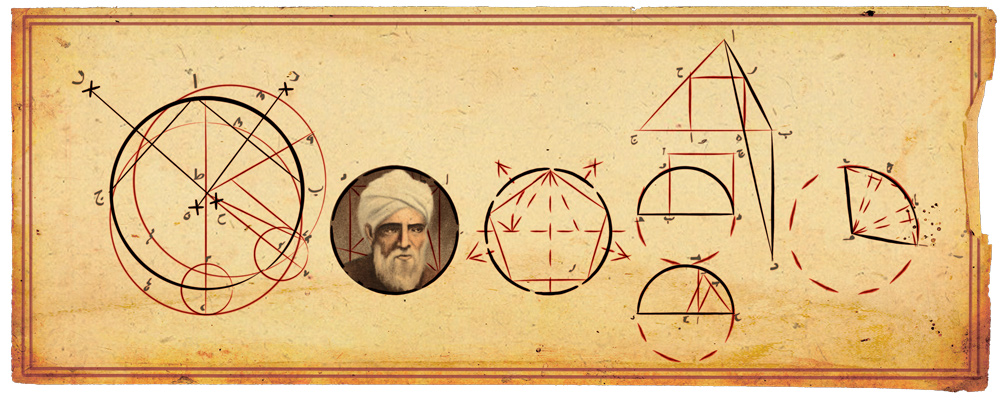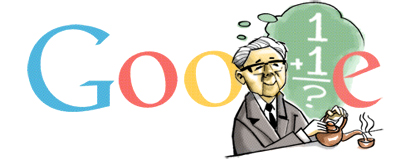George Boole’s 200th Birthday

George Boole was born in Lincoln (Lincolshire) on November 2, 1815. Thus, today is a great day in history of Mathematics and Google has dedicated this interesting doodle to him.
This is the information about this special doodle:
Here’s an easy, yes-or-no question:
Is the universe complex?
YES, of course, you could say; it would be crazy to think otherwise! But on the other hand, British mathematician George Boole taught us that NO, things can be seen as relatively simple; any values can be pared down to yes or no, true or false, or 0 or 1 (which, here at Google, is our personal favorite).
In 1849, Boole was appointed as the first Professor of Mathematics at University College Cork, where he pioneered developments in logic and mathematics. His beautiful binary “Boolean” system was detailed in An Investigation of the Laws of Thought in 1854, which inevitably enabled revolutionary thinking in not just logic and math, but also engineering and computer science.
As one of the most important scientists to have ever worked in Ireland, Boole effectively laid the foundations of the entire Information Age while working from UCC. So it’s fair to say that without George Boole, there’d be no Google! So, as a tribute to Boole’s contributions, artist Leon Hong created today’s doodle, which cycles through all the ANDs, ORs, NOTs, and even XORs of the Boolean states for two discrete variables.
A very happy 11001000th birthday to genius George Boole!
Abû al-Wafâ’ al-Buzjanî’s doodle

This beautiful doodle was published by google in the Persian and Arabic countries last 10th June because in 10th June 940 the great Abû al-Wafâ’ al-Buzjanî was born in Persia. Since 959, he worked in the Caliph’s court in Baghdad among other distinguished mathematicians and scientists who remained in the city after Sharâf al-Dawlâh became the new caliph in 983. He continued to support mathematics and astronomy and built a new observatory in the gardens of his palace in Baghdad (June 988) which included a quadrant over 6 metres long and a sextant of 18 metres.
Abû al-Wafâ’ wrote commentaries on works of Euclid, Ptolemy, Diophantus and al-Khwârizmî, and his works were very important in the developement of Trigonometry and Astronomy.
Today: Emmy Noether’s doodle!

Emmy Noether (23 March 1882 – 14 April 1935) was born in the Bavarian town of Erlangen. Her father was the mathematician Max Noether and she studied Mathematics in the University of Erlangen where Max were teacher. She lectured her dissertation in 1907 under the supervision of Paul Gordan and after that she worked at the Mathematical Institute of Erlangen for seven years without any economical retribution! In 1915, David Hilbert invited her yo join him the Mathematics Department at the University of Gottingen. In that tiem, women were excluded from academic positions and she had to lecture her works under Hilbert’s name. Her habilitation was approved in 1919 and she became a leading member of the Department until 1933 when Germany’s Nazi government dismissed Jews from the university positions (she was Jewish!). She moved to USA where she lived until her death in 1935.

Source: Wikimedia Commons
Her contributions in abstract algebra were exposed by B. L. Van der Waerden in his influential 1931 textbook Moderne Algebra and her contributions were recognized around the world in the 1932 International Congress of Mathematicians in Zürich.
Mercator’s doodle

Gerardus Mercator was born in Rupelmonde (Belgium) exactly 503 years ago (and died in Duisburg on 2 December 1594). He was mathematician and cartographer and he is known for his word map of 1569 based on the projections which represented sailing courses of constant bearing as straight lines:

Source: Wikimedia Commons
Grace Hopper’s 108th Birthday
This doodle was published last year to commemorate Grace Hopper’s 107th Birthday. Hopper (December 9, 1906 – January 1, 1992) was an American computer scientist who first developed the first compiler for a computer programming language. Her ideas led to development of COBOL programming language.

Source: Wikimedia Commons
She was buried in Arlington National Cemetery.
Mikhail Lomonosov’s doodle

Today is Lomonosov’s birthday.
This doodle was published by Google in Russia in the same date of 2011 celebrating his 300th birthday.

Source: Wikimedia Commons
Hua Luogeng’s 101st Birthday

This doodle was published in November 12, 2011 to celebrate Hua Luogeng’s 101st birthday.
Hua Luogeng (12 November 2011 – 12 June 1985) was a Chinese mathematician who became famous for his contributions to the Number Theory.

Source: Wikimedia Commons
You can read some information about him in the Doodle’s page:
Hua Luogeng was well known for two important contributions. One was his work on one of the greatest unsolved mathematical problems, known as Goldbach’s Conjecture…. and yes, it is a little trickier than 1+1, though it involves prime numbers! (We celebrated one of his students, Chen Jungrun, in a previous doodle, who made significant progress on this problem).
Luogeng was also known for his methodology on achieving efficiency, known as “Overall Coordination.” His analogy, taught to most schoolchildren, lays out the premise of wanting to drink tea when you don’t yet have boiled water. The most optimized approach is that you first rinse and fill the kettle and place it on the burner. Meanwhile, you should wash the serving teapot, the tea cups, and prepare the tea leaves. When the water has boiled, you can immediately brew your tea. That’s multi-tasking boiled down for you!
You can always learn something new!
Counting with Count Von Count

I know that this is not the correct place for a doodle dedicated to Count Von Count but five years ago this doodle was published to celebrate the 40th anniversary of Sesame Street. I watched it when I was a child I and I loved Count Von Count who taught children to count. Do you remembere it? There were thunders and lightnings after each number!
Edmond Halley’s doodle

Today is Edmond Halley’s birthday and this doodle was published in yhe United Kingdom in 2011 to celebrate his 355th birthday.
Source: Wikimedia Commons
Shakuntala Devi’s doodle
Shakuntala Devi (November 4, 1929 – April 21, 2013) was a mental calculator who travel around the World showing her arithmetic talent.
According to Wikipedia:
Examples of the problems presented to Devi included calculating the cube root of 61,629,875, and the seventh root of 170,859,375. […] Devi provided the solution to the aforementioned problems (395 and 15, respectively) before [prof. Arthur] Jensen could copy them down in his notebook.
In the 1982 Guinness Book of Records is mentioned that on June 18, 1980, she demonstrated the multiplication of two 13-digit numbers—7,686,369,774,870 × 2,465,099,745,779—picked at random by the Computer Department of Imperial College, London. She correctly answered 18,947,668,177,995,426,462,773,730 in 28 seconds.

Source: Wikimedia Commons
This doddle was published last year to commemorate Devi’s 84th birthday in a lot of countries of the World.